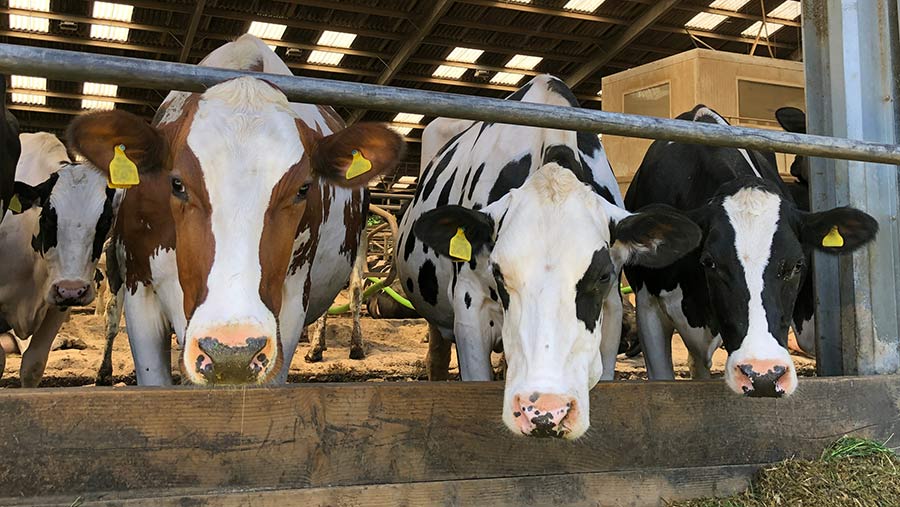Why simple, relevant data is focus of cow behaviour research
 © A Linscott/Adobe Stock
© A Linscott/Adobe Stock Business lore says that what gets measured can be managed or improved.
Yet dairy farmers are at risk of being overloaded with information now that cow tracking technology can record anything from oestrus behaviour and rumination to real-time milk composition.
Not everything that can be measured actually matters in herd management. But there is a gap in the commercial market to interpret on-farm behavioural data for practical use.
It is one that maths professor Edward Codling, of the School of Mathematics, Statistics and Actuarial Science at Essex University, is attempting to fill.
See also: 5 tests to assess your dairy herd’s welfare and comfort
Edward is focusing on what aspects of cow behaviour can be measured and used in an early-warning system to flag health and welfare issues.
Research is building up profiles of normal behaviour for individual cows, rather than changes across a group.
It is possible to detect differences in cows via a wireless remote sensor and relate this to external influences, health or welfare problems.
The resulting algorithms will feed into companies that are designing and building remote measuring sensors for the dairy industry, he says.
Interpreting data
One of the problems with being able to collect so much information is that “black-box” technology can compute thousands of data points, but does not say where the information is from, or come up with probabilities of potential problems.
It works on complex algorithms and the results are not straightforward to interpret, says Edward.
“Scientists can use a lot of complicated data analysis models and throw everything in there.
“We focus on things that farmers understand, so they can use the information to judge whether a cow is lame or not [as an example],” he explains.
“If a farmer relies on a black box saying a cow is lame, it can lead to frustration and not trusting [the information] over time. The key shift [of our work] is to interpret the data into something useful,” he adds.
Technology needs to be easy to use and understand – and relevant to a dairy farming business.
“You need simple tools: using an app on your phone where you might explore a bit, ask a few questions and press a few buttons.
“You don’t need bombarding with information or just being told ‘this cow is ill’ with no further details.”
Early warning system
The advantage of smart technology is to act as an early warning system for large herds, as well as those with multiple staff and/or inexperienced labour.
“It will flag up animals to check, rather than having to inspect every cow in a herd,” says Edward.
He points out that an experienced stockman, familiar with their cows, will be able to identify problems, or sick cows.
However, they only have a snapshot of a cow’s behaviour, character, or appearance at a specific time of day – and for a smaller number of animals than is possible using smart technology.
“An auto sensor can [record] all day, on a bigger scale and with more points of data.
“While they know cows personally, a stockman wouldn’t know an individual cow’s space issues [where she moves around the building].”
As an example, Edward says the research team recorded and analysed 900,000 spatial locations of cows in several dairy herds.
They were then able to accurately predict lameness just by using two of the space-use measures: time spent at the feed area and the cow’s full range of movement.
Next steps
Findings around cow behaviour are now being used to monitor animals in other projects, such as heat stress (looking at implications for shed layout) and tracking conservation-grazing cattle and goats to monitor what they eat – not just where they graze.
Because the heat stress work will involve commercial dairy farmers, Edward expects some direct recommendations from the study could be used by the farmers to change their management.
However, working with Nofence (the virtual fencing system) until mid-2024 might get the most rapid commercial implementation, he says: “We are working directly [with the company] and their existing system and hence any proposed additions can be implemented very quickly.”
For more information, go to essex.ac.uk/research-projects/cow-tracking
- This project was originally funded by the Biotechnology and Biological Sciences Research Council and involves collaboration between University of Essex, Writtle University College, University of Exeter, and the Royal Veterinary College, with industry partner Omnisense (which manufactures wireless tracking sensors).
Heat stress research
- Cows bunch together on hot days. At grass this can be caused by flies or seeking shade, but research is now looking at why they group indoors where there is not the same fly load
- Could be evolved behaviour – an inherent trait – so harder to manage
- Scientists will monitor individual cow behaviour such as ear flicking and water intake and match with neck collar signals
- Measuring gases given off (such as methane and carbon dioxide)
- Looking at cow respiration rates
- Aim is to make practical management easier to avoid negative effects of heat stress
- In collaboration with University of Reading and University of Cardiff
